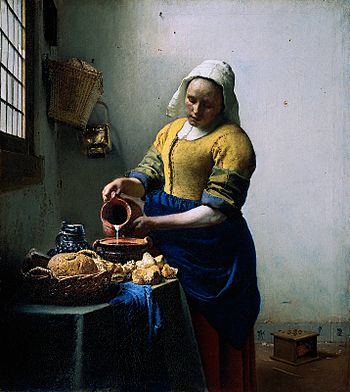I just watched the film “Tim’s Vermeer” which is a fascinating exploration of art and craftsmanship. An inventor and video pioneer, Tim Jenison, sets out to solve the mystery of how Vermeer painted nearly photo-realistic paintings at a time when artists in the Netherlands were still working out the basics of their craft. I have written here before on the fascination for optics, mirrors, and the camera obscura in the Northern Renaissance in my discussion of Svetlana Alper’s The Art of Describing. Jenison finds that Vermeer probably used a series of mirrors to project an image onto a canvas and then used another mirror to view his painting and painstakingly match the tones in the reflection to the image he was creating on the canvas. Jenison reproduces one of Vermeer’s rooms and then sets about to make a Vermeer painting with no formal training in art. His thesis answers questions like: why are there no drawings underneath the paint? and why are there optical distortions in his paintings that only happen with lenses? It is a fascinating film. And then the questions that Jenison is concerned with include questions about what then is art?
Jenison’s experiment used Vermeer’s composition, palette and techniques but is what Jenison produced really art? It is not a Vermeer because Vermeer choosing what he did constitutes a huge part of his art and Jenison made his choices based on making a copy. Jenison could not do what he did without the technology but then again, maybe Vermeer couldn’t either. It is an interesting question.
Somehow, to the modern Romantic sensibility, art married to technology is not “real” art. But I don’t find any of this shocking at all. We dealt with this around photography a hundred and fifty years ago or so. I think that despite the application of technology, and maybe because of it, Vermeer is just as much an artist as Da Vinci or Basquiat. In fact, the Greek word for “art” (τέχνη) and its Latin equivalent (ars) do not signify “fine art” in our modern sense, but were applied to all kinds of human endeavors such as craft, design, or fabrication. Artists are apprenticed in workshops not to learn how to be “artists” in our sense of the term, but to grind minerals into pigments and make paint, to stretch and treat canvas, to learn how to manage the different brushes – in other words, art was something that you did. Vermeer is an artist because he is first a craftsman, and then he hacks the current technology to produce pictures with a visual depth never before experienced.
We experience this phenomena with teaching and learning as instructional designers. Instructional design is often thought of as a technique and not the art of teaching. That instructional design is about tools and not relationships. Teachers sometimes say to me that learning only takes place between the connection between the teacher and the student – everything else is superfluous or gets in the way. When I ask them if this learning takes place in a classroom, they say yes. Does the classroom facilitate the relationship or inhibit it? Are there good arrangements of desks and poor arrangements? Can a white board help those conversations? And they get the idea that yes, even face-to-face classes rely on technology. It is not the technology that is doing the teaching. And technology can be used to facilitate bad teaching, and I resent that because the first thing faculty do is blame the technology! A great example of this is to look at the current state of the conversations around MOOCs.
But another way to look at technology and teaching is to ask one’s self what makes teaching successful? What is good teaching? A few of the measures we use is engagement and interactivity – that is, does the course encourage the interaction between the teacher-student, student-student, and student-content. There is decades of research on the connection between interactivity and student success in courses both online and face-t0-face. Combine this with research on active learning strategies and an instructional designer can start to see a natural fit with teaching and the use of technology in the classroom or in online classes to facilitate that level of engagement. This technology does not make anyone less of a teacher anymore than Vermeer’s mirrors made him any less of an artist.
Related articles
- Eye of the Beholder: Life through the camera obscura (newscientist.com)
- Vermeer Taught Me to Love Again (blogs.getty.edu)
- The Painter and the Philosopher Who Taught Us How to See (wnyc.org)
- Caritas Society presents Tim’s Vermeer (eyeonannapolis.net)





